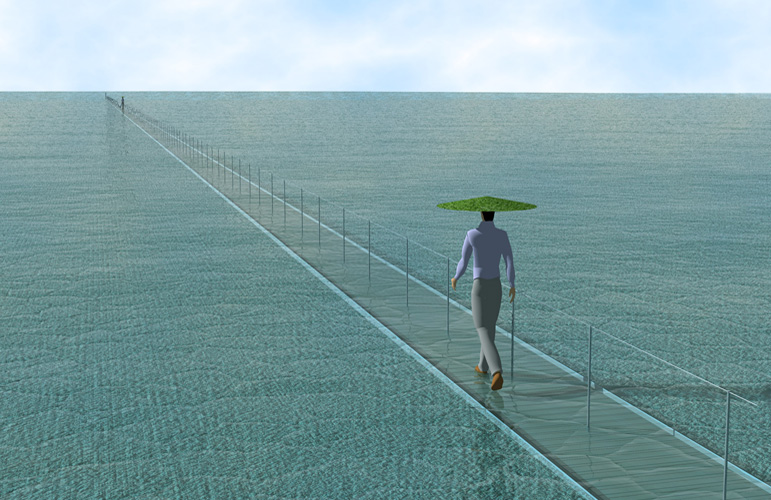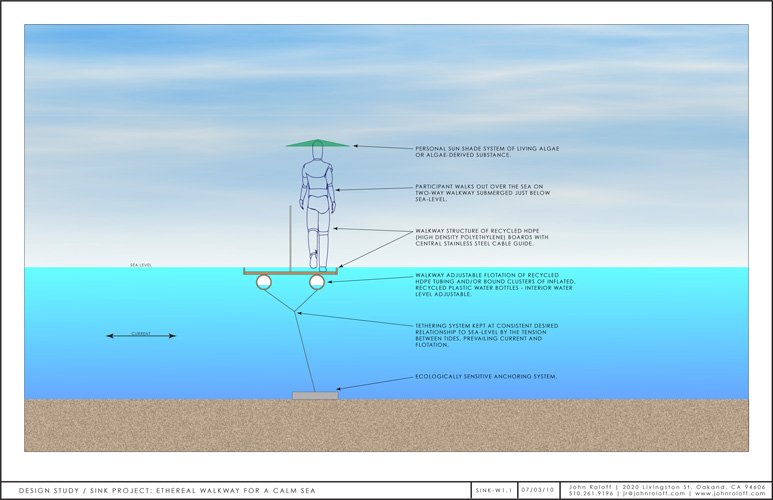SINK - Ethereal Walkway for a Calm Sea
John Roloff / V 1.1 / 2010
Project Concept:
Ethereal Walkway for a Calm Sea creates a passage to a sublime connection with the sea for both participants and viewers of the project – the effect of walking on water. This is achieved by a walkway submerged just beneath the surface of the sea leading from a selected shoreline site directly out to a spot on the ocean far enough to be a journey and isolated enough to create a separation from the shore. The participant on the walkway treads through shallow water over the walking surface made of recycled plastic. A single safety guideline above the center of the walkway provides security while walking. At the end of the walkway is a simple place to stand and turn around for return. The sensation of leaving shore towards a vast expanse of ocean along the walkway is unique to each individual: ethereal, existential, spiritual, communion with nature or tranquility.
The construction of the walkway of recycled materials adds to the commentary and development of an ethos of how humans interface with natural systems. The journey along the walkway is a cycle of voyage and return, analogous to the hydrologic cycles of evaporation, condensation and precipitation of the natural world, and the ecological cycle of material life and repurposing of plastics into new forms and experiences, as well as the sea currents felt at the walk’s apogee and the subtlety of aqueous currents within the participant’s own body. For the viewer looking obliquely from the shore, the walkway’s participants are like apparitions, miraculously traversing the sea’s surface, heading for an untraceable destination.
|
This work has contemporary art references, from the earthwork and conceptual art generation, projects by Robert Smithson, Richard Long, Patricia Johanson and George Trakas have used walking structures or events to evoke landscape and experience, to others like Mark Rothko’s paintings that engage the spiritual in the viewer. The deeper and more salient antecedents for this project and an ongoing strain in my work looks more to European Romanticism and American Transcendentalism, exploration and science. The paintings of J. M. William Turner and Casper David Friedrich with their luminosity and singularity of experience are referenced, also influential are the spirit of poet Samuel Taylor Coleridge’s excursions deep in the mountains of England’s lake country, Scott and others quest for the earth’s poles, John Kensett’s pure expressions of sea and land in his later work and primal visions of those such as the Native American, Black Elk. At the least known and perhaps most resonate level, Ethereal Walkway for a Calm Sea, is a homage to early oceanographer’s such as: H. W. Menard, Harry Hess, Bruce Heezen and Marie Tharp, who’s work exploring the unknown reaches of the ocean to extract the concept of sea-floor spreading as an operative system in our knowledge of the earth and contributing to our evolving ecological vision and ultimate synthesis of humanity and the natural world.
Construction and Materials:
The walkway is constructed primarily of recycled HDPE (High Density Poly-Ethylene) structural elements and inflated recycled water containers. HDPE is a material being used in many current construction practices as an ecological replacement for wood, and is very durable in marine applications. HDPE materials are now used in the US National Park System for bridges, decks and walkways. The walkway itself is made of planks of HDPE anchored to flotation elements either of HDPE tubing and/or plastic water containers inflated with positive air pressure for rigidity bound into flotation units. The walkway is tethered to the bottom using an ecologically sensitive anchoring system. The tethering system is intended to operate in concert with the walkway’s flotation, tidal change and offshore currents to maintain the desired submerged level below the sea surface as well as stability for the walkway in a range of conditions. A personal sunshade system for each participant may consist of a conical hat-like structure of recycled plastic containing living algae, whose population (and shade) increases with exposure to the sun. This shade device is a smaller version of a similar algae/sunlight system done previously in larger form as a gallery installation and proposed pavilions for other walkways.
|



